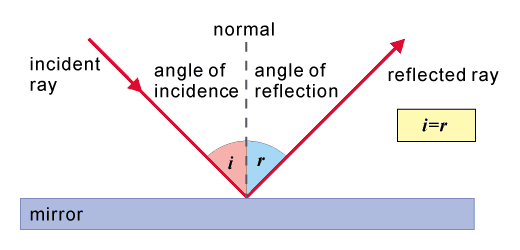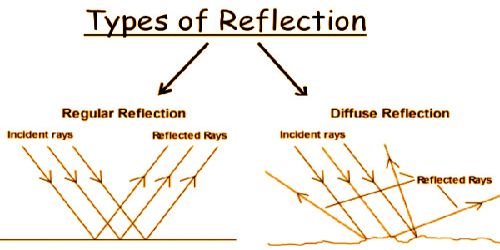Reflection Of Light Study Guide
INTRODUCTION
We cannot see anything when there is darkness around us. It is only when there is a presence of any kind of light, be it natural daylight or artificial electric light, that we can see objects around us. So, what is it that makes us have a visual effect on our surroundings? It is more than just the eyes. It is a reflection, innate property of light, by which light rays can pass through our eyes, and we can enjoy the visual experience of the entities around us.
REFLECTION
- When a ray of light strikes a smooth and shiny surface and comes back down, it is called reflection.
- The ray of light that strikes the surface is known as the incident ray, whereas the ray that returns is called the reflected ray.
- The perpendicular that is drawn on the reflecting surface at the point of reflection is called the normal.
- The angle subtended between the incident ray and the normal is called the angle of incidence.
- The angle subtended between the reflected ray and the normal is called the angle of reflection.
LAWS RELATED TO REFLECTION
If a ray of light approaches any plain surface, like a flat mirror, glass, or water surface, then the incident, as well as the reflected ray, is bound to follow the laws of reflection. According to the laws of reflection,
- The incident ray, the normal line, and the reflected ray always lie on the same plane.
- The angle of incidence is always equal to the angle of reflection.
DIFFERENT TYPES OF REFLECTION
Depending upon the materials involved in the phenomenon of reflection, the actions involved also change. These changes in actions give rise to different types of reflection. They are as follows,
-
- Regular Reflection
Regular reflection is the basic type of reflection that takes place when a glass mirror is taken, which has a lot of reflecting substances like powder-coated to its back. Here, the angle of incidence and angle of reflection is more or less the same.
-
- Diffused Reflection
Diffused reflection occurs when the reflecting material being taken is rough rather than being highly reflective, possessing marks or patches. The incident rays are the reflected rays that are not at all symmetric and hence appear to be darker objects.
-
- Multiple Reflection
A particular light ray can be reflected multiple times if 2 mirrors are taken side by side. The frequency of the images relates inversely to the angle between the two mirrors.
FAQs
1. What is the Angle of Reflection?
The angle between the normal line and the reflected ray is called the angle of reflection.
2. State the laws of reflection?
The laws of reflection are –
i) The incident ray, the normal line, and the reflected ray always lie on the same plane.ii) The angle of incidence is always equal to the angle of reflection.3. What are the types of reflection?
The three types of reflection are Regular, Diffused, and Multiple Reflection
4. Give 2 real-life examples of reflection of light.
Two real-life examples of reflection are the blue color of the sky and the white color of clouds.
We hope you enjoyed studying this lesson and learned something cool about Reflection of Light! Join our Discord community to get any questions you may have answered and to engage with other students just like you! We promise, it makes studying much more fun!😎
SOURCES
- Types of Reflection: https://www.assignmentpoint.com/science/physics/types-reflection.html Accessed 14th April 2022
- Reflection of Light: https://leverageedu.com/blog/reflection-of-light/ Accessed 14th April 2022


